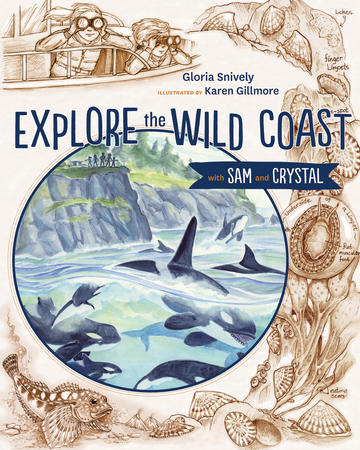 Enlarge Cover
Enlarge Cover
A beautifully illustrated story that teaches children about marine biology and the coastal environment of BC and the Pacific Northwest.
Sam and Crystal travel with their Aunt Kate and Uncle Charlie to a remote location on the Northwest Pacific Coast. Along the way, they see white-sided dolphins, killer whales, tufted puffins, bald eagles, harbour seals, sea lions, sea otters, crabs, sea stars, and much more. Through the character of Aunt Kate, a retired marine biologist, the children explore basic marine ecology concepts. Ada, an Indigenous woman from nearby Salmon Bay Village, is Aunt Kate’s best friend. Through the words of Ada, the children experience a glimpse into an Indigenous view of knowledge and learning. The two ways of knowing overlap and reinforce the importance of sustainability and respecting all the creatures of nature.
This lavishly illustrated book contains colourful and scientifically accurate drawings and paintings. Although a fictional story, Explore the Wild Coast with Sam and Crystal contains a wealth of accessible marine ecology facts and has been informed by Indigenous educators and elders.
- Age:
- 8 to 12
- Grade:
- 3 to 7
The quality and quantity of detail about the marine ecosystems attest to the author’s scholarly expertise. She offers thorough accounts of the most interesting aspects of the lives of each animal and plant Sam and Crystal find. For instance, readers may have some knowledge of why and how the Hermit Crab borrows an empty shell as it outgrows the current one, but they are less likely to know about the battles that take place if two crabs have designs on the same shell. Readers may be familiar with the variety of shapes and colors of shells but are perhaps unaware of how the Wrinkled Whelks drill into mussel shells to feed, and how the mussel egg cases open and close to protect the young ones. These moments of drama are precisely recounted in lively style and give an extra layer of excitement to these books. Along with the more common seashore creatures, like crabs, mussels, sea stars, and gulls, more unusual ones are examined: the Rock Louse, periwinkles, sea anemones, and sea slugs. A list of the organisms arranged in taxonomic categories is found on the last page of each volume.
These beautifully illustrated books tell the fictional tale of Sam and Crystal visiting their Aunt Kate and Uncle Charlie on the West Coast. The books are full of factual information about the flora, fauna, history and traditions of the Canadian Pacific coastline.
Gloria Snively has taken her classic field guide Exploring the Seashore and transformed it into a children’s adventure narrative that leaves no shoreline stone unturned.
A wonderful story that is enjoyable for children (and even adults) of all ages.
As the tide rolls in and out daily in our territory, we are reminded of the abundance of food in our Kwakwaka’wakw oceans, our lands, and our air. As the children in Explore the Wild Coast with Sam and Crystal receive teachings from Ada, they become connected to the spirits within our environment and our ocean. A bond is developed that will provide a foundation of understanding and the need to protect and champion our environment. Sam and Crystal’s journey with Aunt Kate will become a foundation for their future passions and work. Gilakas’la to Dr. Gloria Snively for bringing our young people on a journey of understanding and connection through her story.


